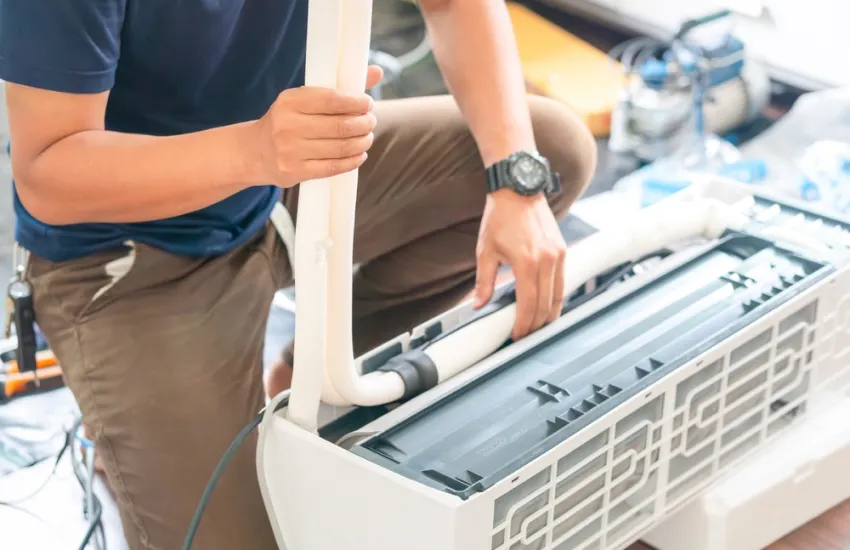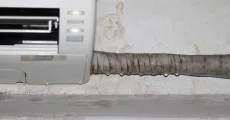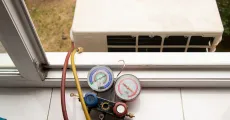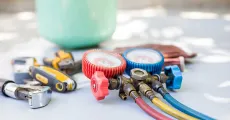How to Troubleshoot and Fix | Air Conditioner Refrigerant Problems?

Refrigerant is the lifeblood of your air conditioner. This guide covers how to identify and fix refrigerant problems, from leaks to low levels, ensuring your AC delivers optimal cooling. Learn the warning signs, when to DIY, and when to call in professionals to maintain efficiency and prevent costly repairs.
How to Troubleshoot and Fix Air Conditioner Refrigerant Problems?
Refrigerant issues are among the most common culprits behind a malfunctioning air conditioner. Whether it’s a leak, incorrect levels, or inefficiencies in the cooling process, refrigerant problems can disrupt your comfort and inflate energy bills. Here’s how to troubleshoot and fix these problems effectively.
Your fridge is a kitchen superstar as it keeps all your food fresh and drinks cold.
But does the fridge feel warm when you open it?
Is there water all over the floor?
Fridge issues are the worst!
Signs of Refrigerant Issues
Before descending into solutions, identify if refrigerant problems are affecting your AC:
- Warm Air from Vents: Indicates low refrigerant levels.
- Ice Formation: Frozen coils signal a refrigerant imbalance.
- Hissing or Bubbling Noises: Suggests a refrigerant leak.
- High Energy Bills: Reduced efficiency due to low refrigerant.
- AC Short Cycling: Frequent on-and-off operation caused by system strain.
Troubleshooting Refrigerant Problems
Check for Visible Leaks
- Inspect refrigerant lines for signs of wear or damage.
- Look for oily residue or frost buildup on the coils or lines.
Monitor Cooling Efficiency
- Measure the temperature of the air coming out of the vents.
- If the air feels warm despite the AC running, it could indicate low refrigerant.
Listen for Unusual Sounds
- Hissing or bubbling noises point to escaping refrigerant.
Fixing Refrigerant Issues
Minor Repairs and Maintenance
- Seal Small Leaks: Use an AC leak sealant for minor leaks, but this is a temporary fix.
- Clean Coils: Dirty coils can mimic refrigerant problems. Clean them to improve efficiency.
Refilling Refrigerant
Recharging refrigerant is not a DIY job. Only certified technicians should handle refrigerant due to its environmental impact and regulatory restrictions.
How to Prevent Refrigerant Problems?
- Schedule Regular Maintenance: Annual inspections can catch issues early.
- Ensure Proper Installation: Poor installation often leads to refrigerant leaks.
- Keep Coils Clean: Prevent dirt buildup that can reduce efficiency.
- Monitor Energy Bills: Sudden spikes might indicate refrigerant issues.




CLT Appliance Repair: Your Refrigerant Problem Solvers
Refrigerant problems require attention from professionals who understand the intricacies of your air conditioner. At CLT Appliance Repair, we specialize in resolving refrigerant-related issues quickly and effectively.
Our skilled technicians diagnose leaks, handle refrigerant refills, and ensure your system operates at peak performance. With our expertise, you’ll experience better cooling, improved efficiency, and peace of mind. If your AC isn’t performing as it should, let us take care of it. Contact us now for expert air conditioner repair charlotte nc
Don't let a malfunctioning Air conditioner disrupt your daily life. Contact CLT Appliance Repair today at 704-606-9043 to schedule your Air conditioner repair service.
We'll have your fridge back to optimal performance in no time!
- Air Conditioner Not Cooling
- Air Conditioner Leaking Water
- Air Conditioner Making Noise
- Air Conditioner Not Turning On
- Air Conditioner Frozen
- Air Conditioner Sensor Issues
- Air Conditioner Electrical Issues
- Air Conditioner Compressor Problems
- Air Conditioner Thermostat Issues
- Tips for maintaining an air conditioner.
FAQs
No, refrigerant handling requires certification due to its environmental impact and safety concerns. Always hire a licensed technician.
Common signs include hissing sounds, ice on the coils, and reduced cooling performance. Professionals use specialized tools to pinpoint leaks accurately.
Older units often use R-22, while newer systems use R-410A or other eco-friendly alternatives. Check your AC’s user manual or contact a technician.
You don’t need regular checks unless there’s a problem. A properly functioning system doesn’t consume refrigerant.
Low refrigerant can overheat the compressor, leading to costly repairs or even a total system failure.
Appliance Repair Indian Land SC | Appliance Repair Indian Trail NC | Appliance Repair Pineville NC | Appliance Repair Rock Hill SC | Appliance Repair Belmont NC | Appliance Repair Matthews NC | Appliance Repair Lancaster SC | Appliance Repair Cornelius NC | Appliance Repair Fort Mill SC | Appliance Repair Concord NC | Appliance Repair Denver NC | Appliance Repair Monroe NC | Appliance Repair Mooresville NC | Appliance Repair Harrisburg NC | Appliance Repair Lake Wylie SC | Appliance Repair Huntersville NC | Appliance Repair Kannapolis NC | Appliance Repair Mint Hill NC | Appliance Repair Waxhaw NC | Appliance Repair Troutman NC | Appliance Repair Davidson NC | Appliance Repair Gastonia NC | Appliance Repair Charlotte NC

